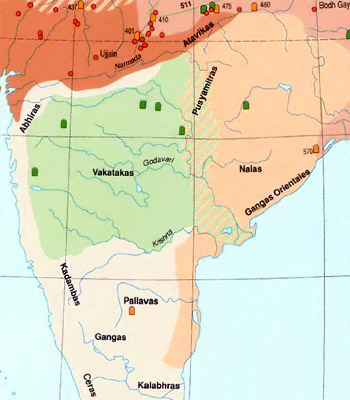 Branches of Vakataka dynasty reveal the complete lineage of the dynasty. After Pravarsena I there have been four divisions of the branches. Two branches are identified and two are not known. Pravarpura-Nandivardhana branch and the Vatsagulma branch are the known branches.
Branches of Vakataka dynasty reveal the complete lineage of the dynasty. After Pravarsena I there have been four divisions of the branches. Two branches are identified and two are not known. Pravarpura-Nandivardhana branch and the Vatsagulma branch are the known branches.
Pravarapura-Nandivardhana branch
This branch ruled from sites like Pravarapura in Wardha district and Mansar and Nandivardhan (Nagardhan) in Nagpur district. They had marital relations with the Imperial Guptas.
Rudrasena I
Rudrasena I is the son of Gautamiputra, who ruled from Nandivardhana. The only stone inscription of Rudrasena I`s reign discovered was found at Deotek in Chandrapur district.
Prithvisena I
Rudrasena I was succeeded by Prithvisena I (355-380) and he was succeeded by his son named Rudrasena II.
Rudrasena II, Divakarasena and Pravarasena II
It is believed that Rudrasena II was married to Prabhavatigupta, the daughter of the Gupta King Chandragupta II (375-413/15). Rudrasena II died after a very short reign in 385 C.E. Prabhavatigupta (385 - 405) ruled as a trustee on behalf of her two sons, Divakarasena and Damodarasena for 20 years. Vakatakas were a part of the Gupta Empire during this period.
Pravarasena II composed the Setubandha in Maharashtri Prakrit language. He shifted the capital of Nandivardhana to Pravarapura that was a new city founded by him. A temple was dedicated to Lord Rama.
Narendrasena and Prithvisena II
Narendrasena (440-460) succeeded Pravarsena II under whom the Vakataka had spread themselves to some central Indian states. Prithvisena II succeeded his father Narendrasena in 460 A.D. After his death in 480, his kingdom was annexed by Harishena of the Vatsagulma branch.
Vatsagulma branch
The Buddhist viharas and chaityas of Ajanta Caves were built under the patronage of the Vatsagulma branch of the Vakataka rulers. This branch was founded by Sarvasena, the second son of Pravarasena I after his death. King Sarvasena made Vatsagulma his capital. Vatsagulma branch ruled the region between the Sahyadari Mountains Range and the Godavari River.
Sarvasena
Dharmamaharaja title was taken by Sarvasena. He has composed several works. Vindhyasena succeeded Sarvasena.
Vindhyasena
Vindhysena also took the title of Dharmamaharaja. He defeated the ruler of Kuntala, his southern neighbour. Pravarasena II succeeded Vindhyasena.
Pravarsena II
During the rule of Pravarasena II the Kingdom witnessed lot of development. However he could not rule for a long time. He was succeeded by his minor son who was only 8 years old when his father died.
Devasena
Devasena (c.450 - 475) succeeded his father. His administration was run by his minister Hastibhoja.
Harishena
Devasena was succeeded by Harishena. He patronised Buddhist architecture, art and culture. Some of the Buddhist caves at Ajanta, two viharas were decorated with painting and sculptures during Harishena`s reign. Harishena was succeeded by two rulers whose identification is not known. The decline of dynasty is unknown. It is believed that they were defeated by the Kalachuri of Mahismati.



















